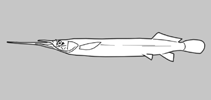Nomorhamphus rex Huylebrouck, Hadiaty & Herder, 2012
Upload your photos and videos
Google imageNo image available for this species;
drawing shows typical species in Zenarchopteridae.
Google imageNo image available for this species;
drawing shows typical species in Zenarchopteridae.
Classification / Names Nombres comunes | Sinónimos | Catalog of Fishes(Género, Especie) | ITIS | CoL | WoRMS | Cloffa
> Beloniformes (Needle fishes) > Zenarchopteridae (Internally fertilized halfbeaks)
Etymology: Nomorhamphus: Greek, nema = filament + Greek, rhamphos = bill, peak (Ref. 45335); rex: Name from Latin meaning king; referring to the teeth, similar to the dentition of the late Cretaceous Tyrannosaurus rex; noun in apposition.
Etymology: Nomorhamphus: Greek, nema = filament + Greek, rhamphos = bill, peak (Ref. 45335); rex: Name from Latin meaning king; referring to the teeth, similar to the dentition of the late Cretaceous Tyrannosaurus rex; noun in apposition.
Environment: milieu / climate zone / depth range / distribution range Ecología
; agua dulce pelágico; rango de profundidad 0 - ? m. Tropical
Distribución Países | Áreas FAO | Ecosistemas | Ocurrencias, apariciones | Point map | Introducciones | Faunafri
Asia: Indonesia.
Tamaño / Peso / Age
Maturity: Lm ? range ? - ? cm
Max length : 4.4 cm SL macho / no sexado; (Ref. 91778); 6.4 cm SL (female)
Max length : 4.4 cm SL macho / no sexado; (Ref. 91778); 6.4 cm SL (female)
Short description Claves de identificación | Morfología | Morfometría
Radios blandos dorsales (total) : 11 - 13; Radios blandos anales: 14 - 15; Vértebra: 37 - 40. This species is distinguished from its congeners by the shape of the andropodium in males: sickle-shape spiculus is curved dorsally, the proximal and middle segments in contact with the distal tip of the third anal-fin ray; the spiculus' distal segments are curved ventrally, no contact to third anal-fin ray; in males, the second anal-fin ray with 3 or 4 segments proximal to paired spines, third or fourth segment with a dorsal and a ventral row of 'subsegments' forming squares and rectangles of different sizes, the third or fourth segment appears to be subdivided into two separate rays, from the half of its length up to the spines, with a varying number of subsegments (?5 subsegments per row); first segment of the first anal-fin ray slightly constricted longitudinally, giving the appearance of 2 distinct rays; third anal-fin ray composed of 2 elongate segments, each approximately half the length of the entire ray, followed by a few short segments at the distal tip, which contact the spiculus; the fourth anal-fin ray divided into 3 rows from approximately the third of its length, forming a kind of a covering for the third anal fin ray with one dorsal and two lateral rows beneath (Ref. 91778). Nomorhamphus rex have a relatively longer lower jaw, LJLB 5.7-11.3 times in SL vs. 13.4-15.9 in N. ebrardtii and 8.8-22.2 in N. kolonodalensis (Ref. 44897).
Found in small, fast flowing river of few meters width that are partially covered by forest canopy, with gravel and sand bottoms. Occurs with Oryzias celebensis, Telmatherina cf. bonti,
Anabas testudineus, Channa striata, Trichopodus pectoralis, Trichopodus pectoralis, Mugilogobius sp., Aplocheilus panchax, and Poecilia reticulata (Ref. 91778).
Life cycle and mating behavior Madurez | Reproducción | Puesta | Huevos | Fecundidad | Larva
Main reference
Upload your references | Referencias | Coordinador | Colaboradores
Huylebrouck, J., R.K. Hadiaty and F. Herder, 2012. Nomorhamphus rex, a new species of viviparous halfbeak (Atherinomorpha: Beloniformes: Zenarchopteridae) endemic to Sulawesi Selatan, Indonesia. The Raffles Bulletin of Zoology 60(2):477-485. (Ref. 91778)
CITES
Not Evaluated
Threat to humans
Harmless
Human uses
FAO - Publication: search | FishSource |
Más información
Trophic ecology
componentes alimenticios
Composición de la dieta
consumo de alimento
Food rations
Despredadores
componentes alimenticios
Composición de la dieta
consumo de alimento
Food rations
Despredadores
Ecology
Ecología
Ecología
Population dynamics
Coeficiente del crecimiento para
Max. ages / sizes
Length-weight rel.
Length-length rel.
Length-frequencies
Mass conversion
Reclutamiento
Abundancia
Coeficiente del crecimiento para
Max. ages / sizes
Length-weight rel.
Length-length rel.
Length-frequencies
Mass conversion
Reclutamiento
Abundancia
Life cycle
Reproducción
Madurez
Maturity/Gills rel.
Fecundidad
Puesta
Spawning aggregations
Huevos
Egg development
Larva
Dinámica larvaria
Reproducción
Madurez
Maturity/Gills rel.
Fecundidad
Puesta
Spawning aggregations
Huevos
Egg development
Larva
Dinámica larvaria
Anatomy
Superficie branquial
Brain
Otolith
Superficie branquial
Brain
Otolith
Physiology
Body composition
Nutrients
Consumo del oxígeno
Tipo de natación
Velocidad de natación
Visual pigments
Fish sound
Diseases & Parasites
Toxicity (LC50s)
Body composition
Nutrients
Consumo del oxígeno
Tipo de natación
Velocidad de natación
Visual pigments
Fish sound
Diseases & Parasites
Toxicity (LC50s)
Genetics
Genética
Heterozygosity
heritabilidad
Genética
Heterozygosity
heritabilidad
Human related
Aquaculture systems
Perfiles de acuicultura
Razas
Ciguatera cases
Stamps, coins, misc.
Aquaculture systems
Perfiles de acuicultura
Razas
Ciguatera cases
Stamps, coins, misc.
Herramientas
E-book | Guía de campo | Asistente para frecuencias de tallas | Herramienta de ciclo de vida | Mapa de puntos | Classification Tree
| Catch-MSY |
Special reports
Download XML
Fuentes de Internet
AFORO (otoliths) | Aquatic Commons | BHL | Cloffa | BOLDSystems | Websites from users | Check FishWatcher | CISTI | Catalog of Fishes: Género, Especie | DiscoverLife | ECOTOX | FAO - Publication: search | Faunafri | Fishipedia | Fishtrace | GenBank: genome, nucleotide | GloBI | Google Books | Google Scholar | Google | IGFA World Record | MitoFish | Otolith Atlas of Taiwan Fishes | PubMed | Reef Life Survey | Socotra Atlas | Árbol de la vida | Wikipedia: Go, búsqueda | World Records Freshwater Fishing | Zoobank | Expediente Zoológico
Estimates based on models
Phylogenetic diversity index (Ref. 82804): PD50 = 0.5000 [Uniqueness, from 0.5 = low to 2.0 = high].
Bayesian length-weight: a=0.00457 (0.00200 - 0.01044), b=3.03 (2.82 - 3.24), in cm total length, based on LWR estimates for this (Sub)family-body shape (Ref. 93245).
Nivel trófico (Ref. 69278): 3.1 ±0.4 se; based on size and trophs of closest relatives
Fishing Vulnerability (Ref. 59153): Low vulnerability (10 of 100).




